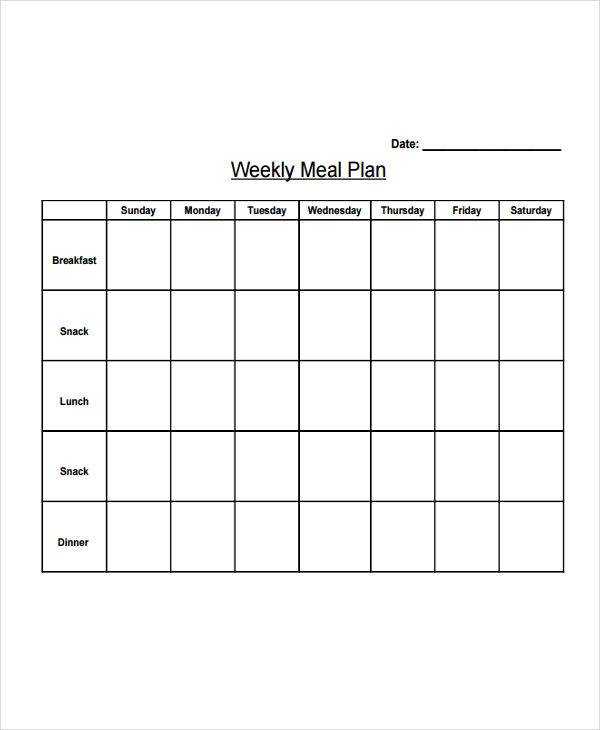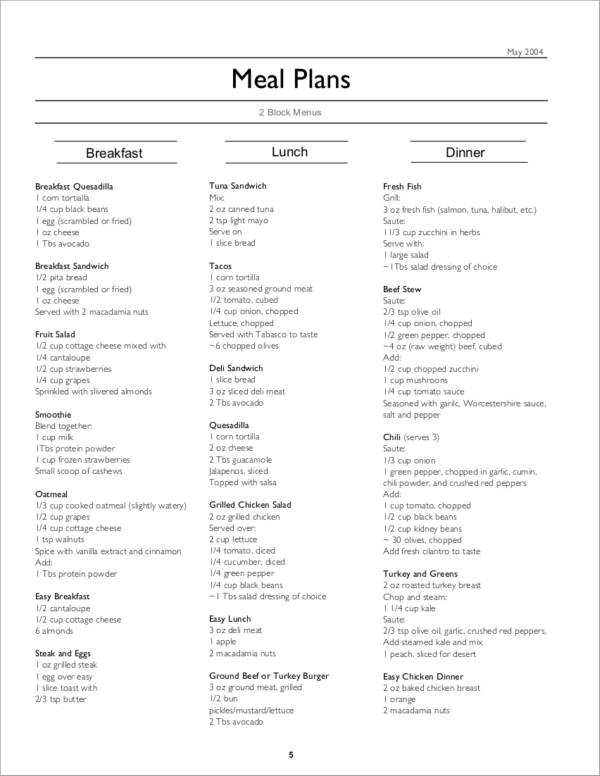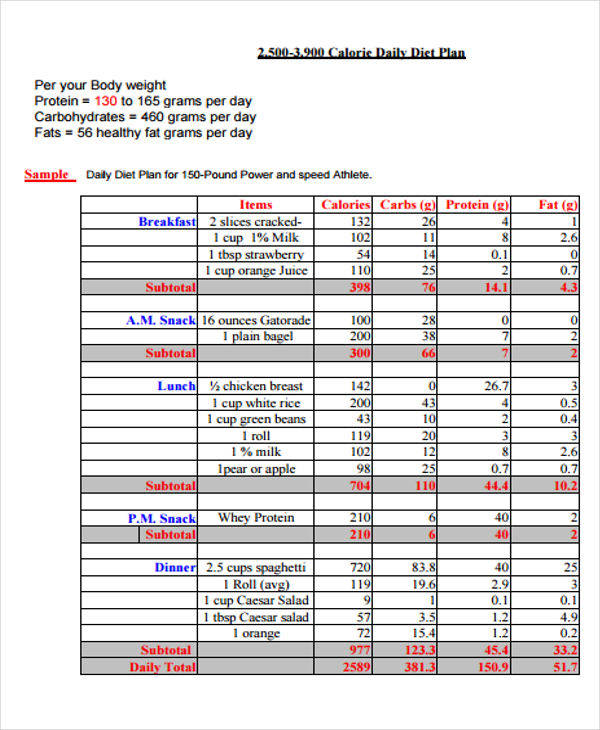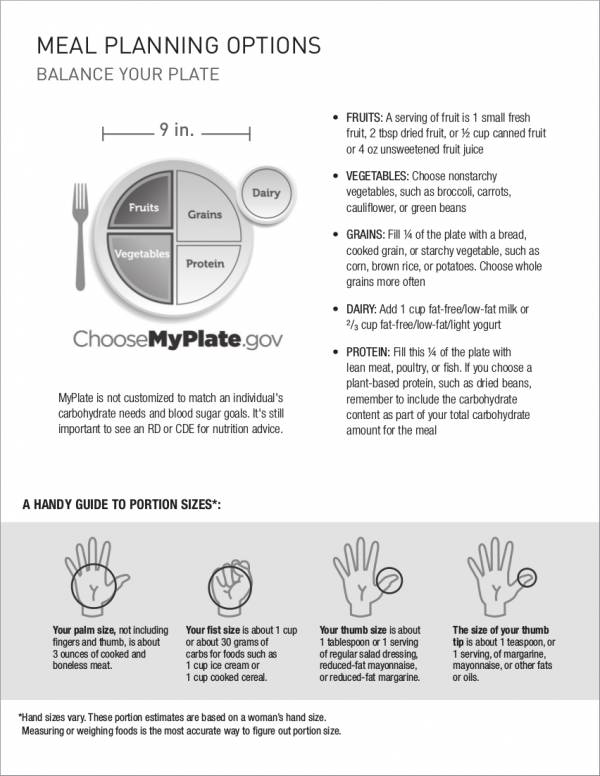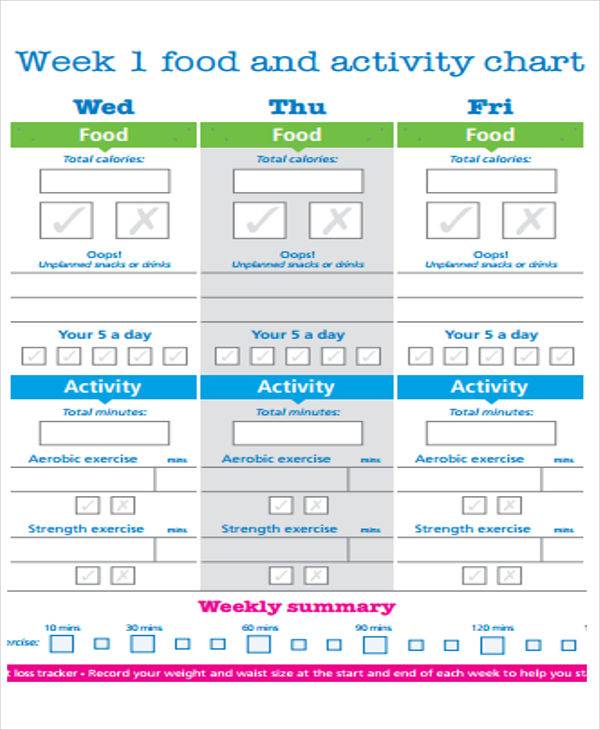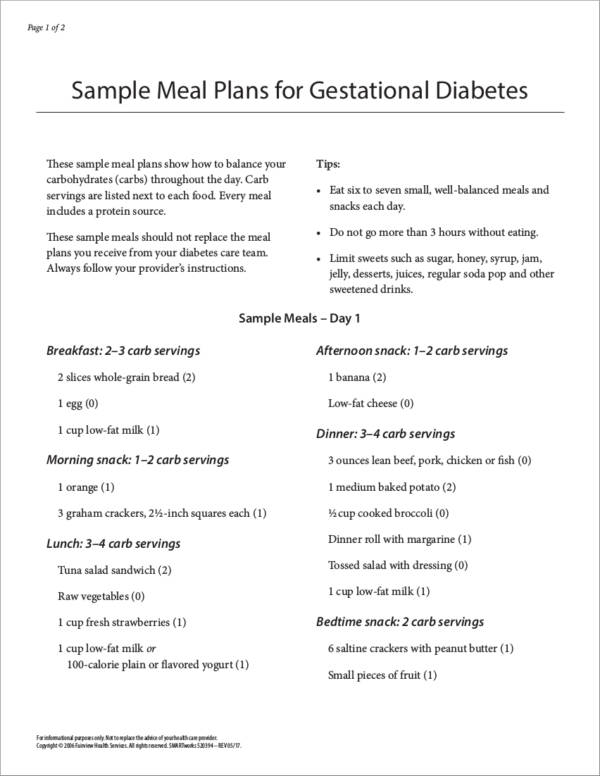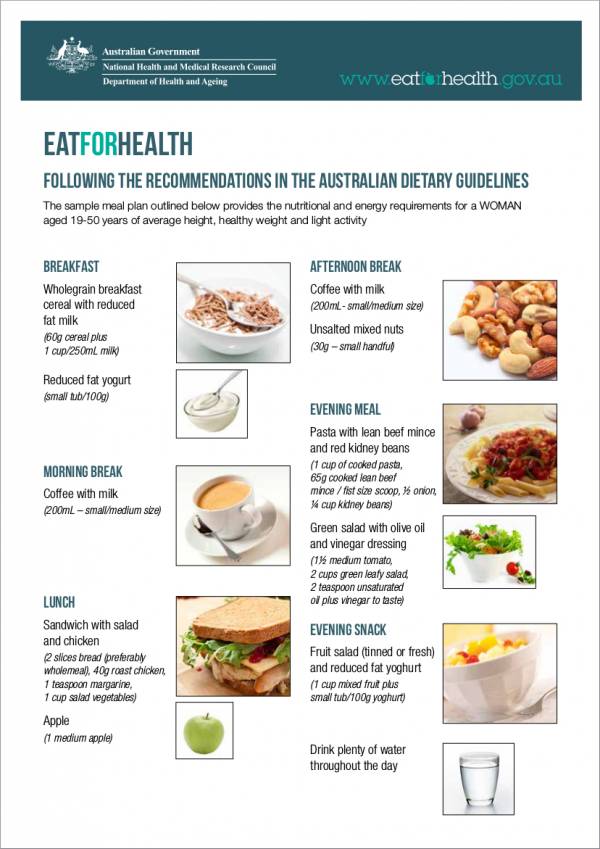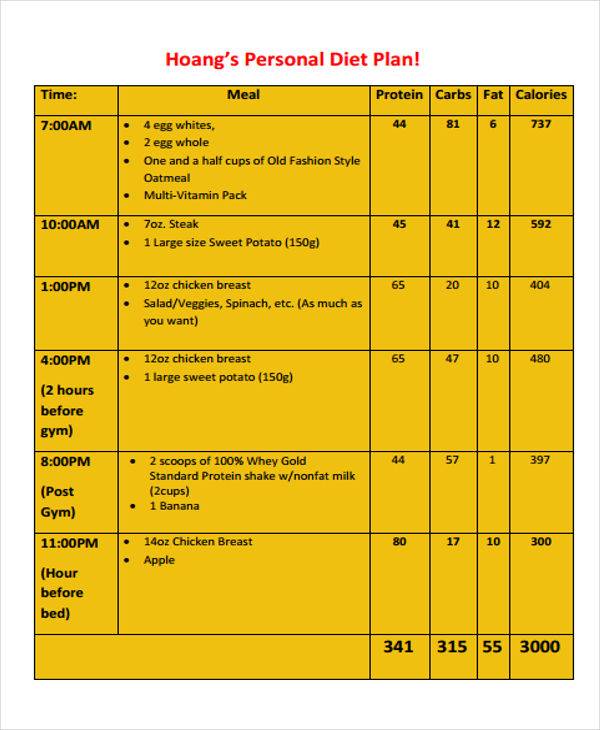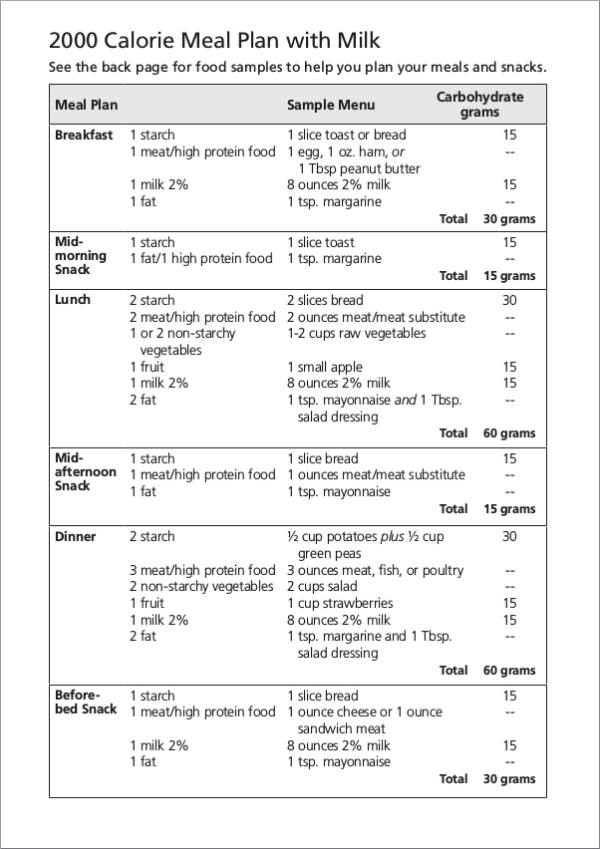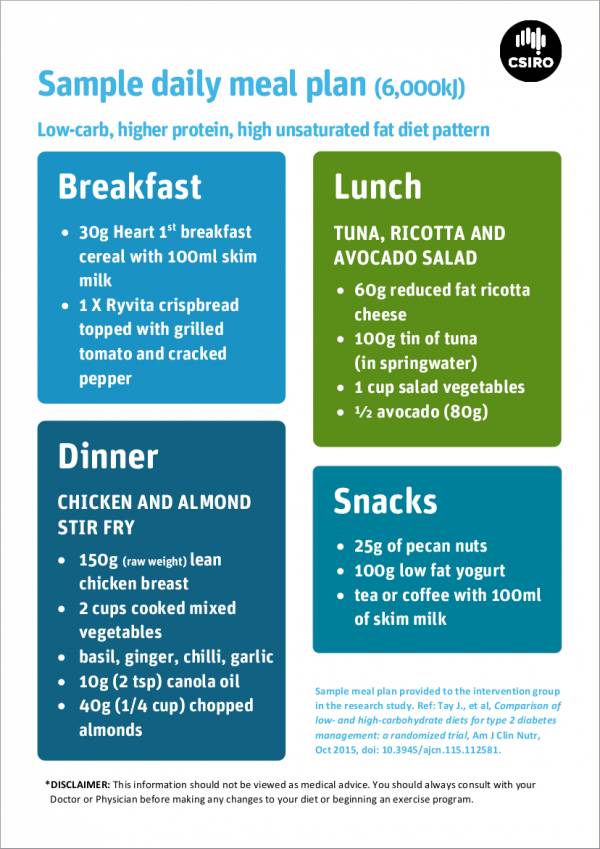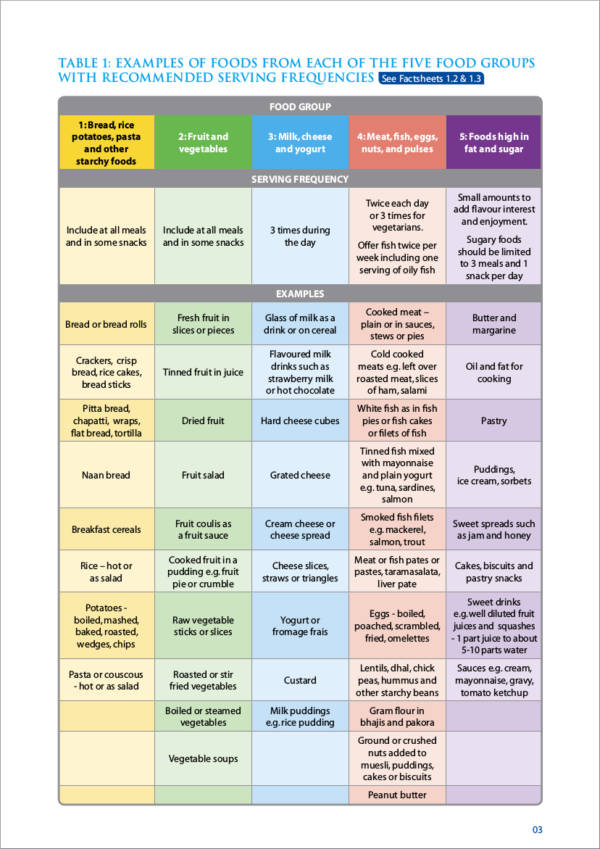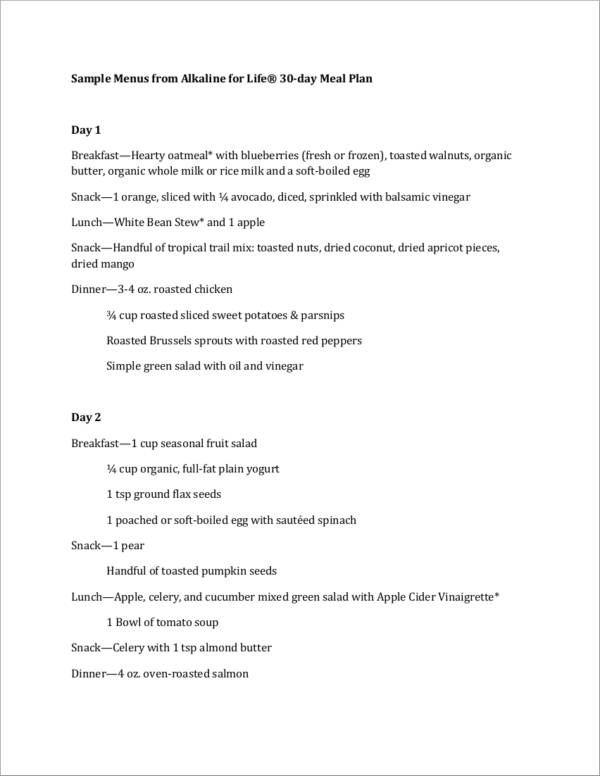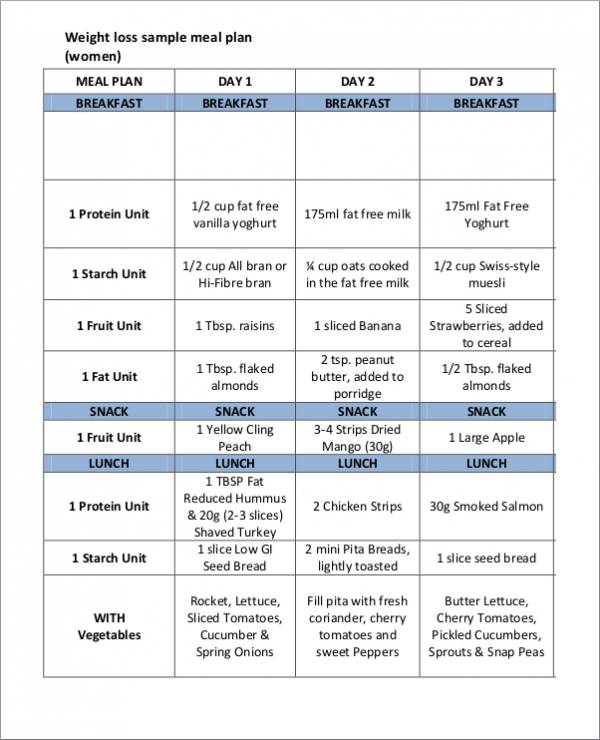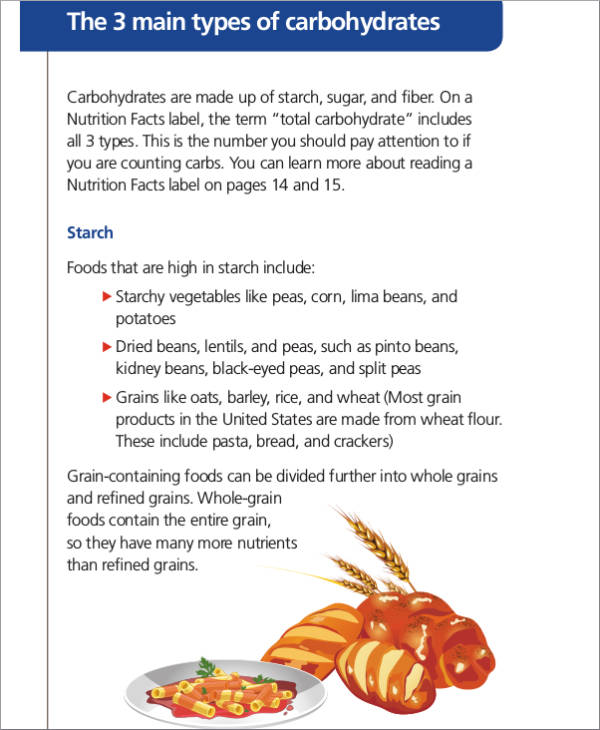Pursuing a healthy lifestyle comes with changing your eating habits. What your body consumes has a direct impact on your wellbeing. Fulfill your fitness goals with a suitable diet plan sample. Keeping track of your food intake and being conscious of your meal choices is among the first steps of turning your way of life around towards a more physically and mentally vigorous life. It’s a great addition to your self-care planner as you seek holistic development.
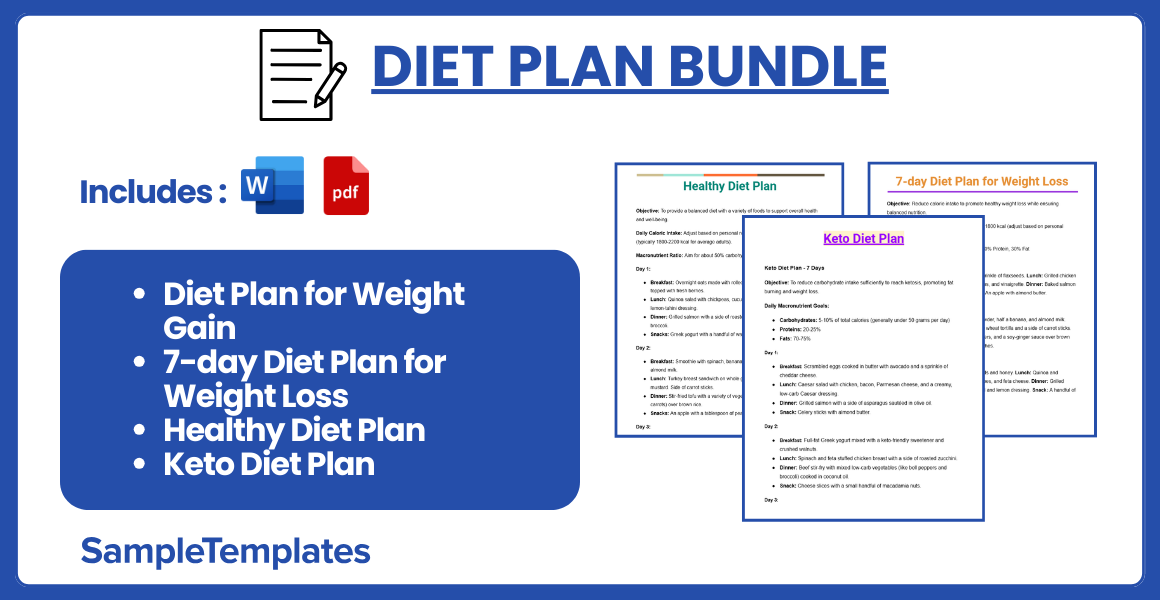
Diet Plan for Weight Gain
Objective: Increase caloric intake with nutrient-dense foods to support healthy weight gain and muscle growth.
Daily Caloric Intake:
- Total Calories: Approximately 3000 to 3500 kcal
- Macronutrient Ratio: 50% Carbohydrates, 30% Protein, 20% Fat
Meal Breakdown:
Breakfast:
- Oatmeal with Whole Milk (1 cup cooked oatmeal, 1 cup whole milk, topped with banana and a tablespoon of honey)
- Greek Yogurt (1 cup, mixed with a handful of almonds and a sprinkle of chia seeds)
- Orange Juice (1 glass)
Mid-Morning Snack:
- Protein Smoothie (1 scoop of protein powder, 1 banana, 1 tablespoon of peanut butter, 1 cup of Greek yogurt, and 1/2 cup of oats blended with whole milk)
Lunch:
- Chicken Breast (200g grilled)
- Brown Rice (1 cup cooked)
- Steamed Vegetables (1 cup mixed vegetables like broccoli, carrots, and peas)
- Avocado Salad (1 avocado served with cherry tomatoes and olive oil dressing)
Afternoon Snack:
- Trail Mix (A mix of nuts, seeds, and dried fruits – 1 cup)
- Cheese and Crackers (4 whole-grain crackers with slices of cheddar cheese)
Dinner:
- Salmon Fillet (200g, oven-baked)
- Sweet Potato (1 large, baked)
- Quinoa (1 cup cooked)
- Green Salad (Mixed greens with vinaigrette dressing)
Evening Snack:
- Cottage Cheese (1 cup, with slices of pineapple or peaches)
- Whole Grain Bread (2 slices, with a spread of butter or jam)
Hydration:
- Water: 8-10 glasses throughout the day
- Optional: Herbal teas or seltzers without added sugars
Supplements:
- Consider a weight gainer supplement or meal replacement shakes if needed and consult with a healthcare provider.
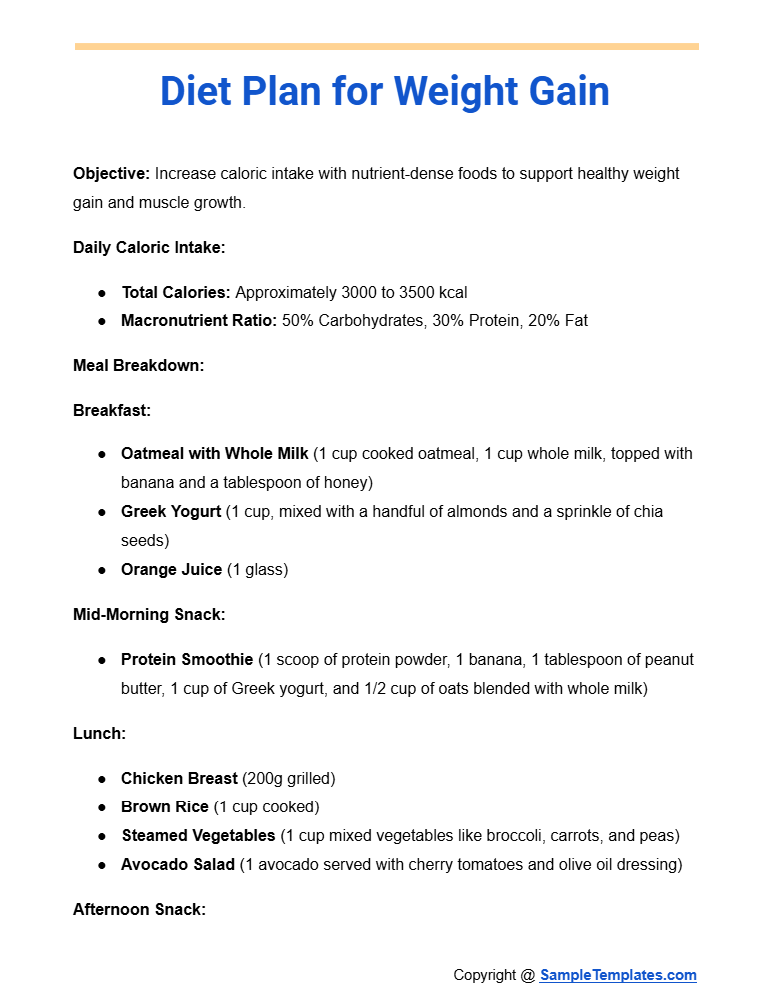
7-day Diet Plan for Weight Loss
Objective: Reduce calorie intake to promote healthy weight loss while ensuring balanced nutrition.
Daily Caloric Intake: Approximately 1500 to 1800 kcal (adjust based on personal needs and activity level)
Macronutrient Ratio: 40% Carbohydrates, 30% Protein, 30% Fat
Day 1:
Breakfast: Greek yogurt with berries and a sprinkle of flaxseeds. Lunch: Grilled chicken salad with mixed greens, cucumbers, tomatoes, and vinaigrette. Dinner: Baked salmon with asparagus and a side of quinoa. Snack: An apple with almond butter.
Day 2:
Breakfast: Smoothie with spinach, protein powder, half a banana, and almond milk. Lunch: Turkey and avocado wrap with whole wheat tortilla and a side of carrot sticks. Dinner: Stir-fried tofu with broccoli, bell peppers, and a soy-ginger sauce over brown rice. Snack: Cottage cheese with sliced peaches.
Day 3:
Breakfast: Oatmeal topped with sliced almonds and honey. Lunch: Quinoa and chickpea salad with red onions, cherry tomatoes, and feta cheese. Dinner: Grilled shrimp over a mixed green salad with olive oil and lemon dressing. Snack: A handful of mixed nuts.
Day 4:
Breakfast: Two scrambled eggs with spinach and mushrooms. Lunch: Lentil soup with a side of whole-grain bread. Dinner: Turkey burger (no bun) with a side of sweet potato fries. Snack: Greek yogurt with a sprinkle of granola.
Day 5:
Breakfast: Smoothie bowl with berries, banana, and a sprinkle of chia seeds. Lunch: Baked tilapia with a side salad and vinaigrette. Dinner: Beef stir-fry with vegetables served over cauliflower rice. Snack: Raw vegetables with hummus.
Day 6:
Breakfast: Whole grain pancakes topped with fresh strawberries. Lunch: Chicken Caesar salad with low-calorie dressing. Dinner: Zucchini noodles with bolognese sauce. Snack: An orange and a handful of almonds.
Day 7:
Breakfast: Cottage cheese with sliced pineapple. Lunch: Roasted vegetable and goat cheese wrap. Dinner: Grilled pork chop with steamed green beans and mashed butternut squash. Snack: Protein bar.
General Guidelines:
- Drink at least 8 glasses of water per day.
- Feel free to swap similar meals from different days according to personal taste.
- Adjust portion sizes based on individual dietary needs and goals.
- Supplement this diet with regular physical activity for optimal results.
- Consult with a dietitian for personalized advice and adjustments

Healthy Diet Plan
Objective: To provide a balanced diet with a variety of foods to support overall health and well-being.
Daily Caloric Intake: Adjust based on personal needs, activity level, and dietary goals (typically 1800-2200 kcal for average adults).
Macronutrient Ratio: Aim for about 50% carbohydrates, 20% protein, and 30% fats.
Day 1:
- Breakfast: Overnight oats made with rolled oats, chia seeds, almond milk, and topped with fresh berries.
- Lunch: Quinoa salad with chickpeas, cucumber, tomato, red onion, and a lemon-tahini dressing.
- Dinner: Grilled salmon with a side of roasted sweet potatoes and steamed broccoli.
- Snacks: Greek yogurt with a handful of walnuts.
Day 2:
- Breakfast: Smoothie with spinach, banana, protein powder, and unsweetened almond milk.
- Lunch: Turkey breast sandwich on whole grain bread with lettuce, tomato, and mustard. Side of carrot sticks.
- Dinner: Stir-fried tofu with a variety of vegetables (bell peppers, snap peas, carrots) over brown rice.
- Snacks: An apple with a tablespoon of peanut butter.
Day 3:
- Breakfast: Two poached eggs on a whole-grain English muffin with sliced avocado.
- Lunch: Lentil soup with a side salad dressed with vinaigrette.
- Dinner: Chicken breast baked with herbs, garlic, and olive oil, served with quinoa and steamed green beans.
- Snacks: A peach and a handful of almonds.
Day 4:
- Breakfast: Greek yogurt with granola and mixed berries.
- Lunch: Spinach salad with grilled shrimp, avocado, mango, and a citrus vinaigrette.
- Dinner: Beef stir-fry with vegetables served over whole-wheat noodles.
- Snacks: Cucumber slices with hummus.
Day 5:
- Breakfast: Whole grain cereal with milk and sliced banana.
- Lunch: Grilled chicken wrap with whole wheat tortilla, mixed greens, and Greek yogurt sauce.
- Dinner: Baked cod with a crust of crushed pistachios, side of asparagus, and a quinoa pilaf.
- Snacks: A pear and a string cheese.
Day 6:
- Breakfast: Scrambled eggs with spinach, mushrooms, and feta cheese.
- Lunch: Black bean burger on a whole grain bun with lettuce, tomato, and avocado.
- Dinner: Pork tenderloin with roasted Brussels sprouts and a sweet potato.
- Snacks: Mixed berries and a handful of pumpkin seeds.
Day 7:
- Breakfast: Cottage cheese with sliced pineapple and a sprinkle of flaxseeds.
- Lunch: Baked falafel with a side of tabbouleh and tzatziki sauce.
- Dinner: Roast chicken with mixed roasted vegetables (carrots, parsnips, beets).
- Snacks: An orange and a few walnuts.
General Guidelines:
- Hydration: Drink at least 8 cups of water throughout the day.
- Moderation: Limit high-sugar and high-fat foods, focusing on whole and minimally processed items.
- Variety: Rotate different foods in each food group to ensure a wide range of nutrients.
- Portion Control: Use smaller plates, bowls, and cups to help control portions
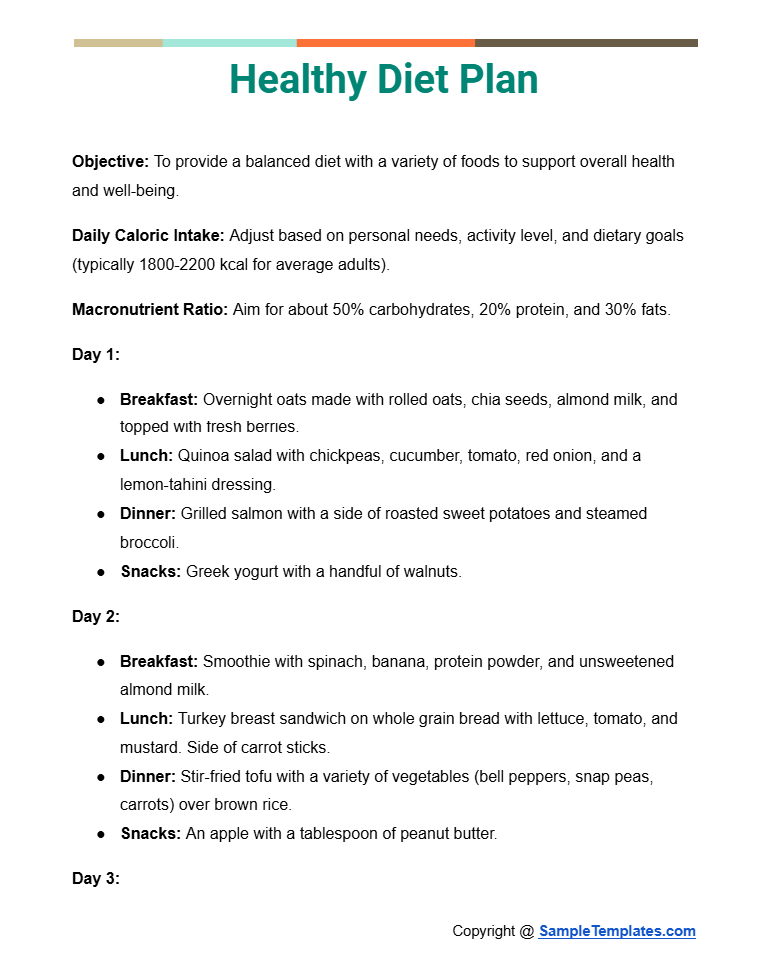
Keto Diet Plan
Keto Diet Plan – 7 Days
Objective: To reduce carbohydrate intake sufficiently to reach ketosis, promoting fat burning and weight loss.
Daily Macronutrient Goals:
- Carbohydrates: 5-10% of total calories (generally under 50 grams per day)
- Proteins: 20-25%
- Fats: 70-75%
Day 1:
- Breakfast: Scrambled eggs cooked in butter with avocado and a sprinkle of cheddar cheese.
- Lunch: Caesar salad with chicken, bacon, Parmesan cheese, and a creamy, low-carb Caesar dressing.
- Dinner: Grilled salmon with a side of asparagus sautéed in olive oil.
- Snack: Celery sticks with almond butter.
Day 2:
- Breakfast: Full-fat Greek yogurt mixed with a keto-friendly sweetener and crushed walnuts.
- Lunch: Spinach and feta stuffed chicken breast with a side of roasted zucchini.
- Dinner: Beef stir-fry with mixed low-carb vegetables (like bell peppers and broccoli) cooked in coconut oil.
- Snack: Cheese slices with a small handful of macadamia nuts.
Day 3:
- Breakfast: Omelet with mushrooms, spinach, and Gruyère cheese.
- Lunch: Tuna salad with celery, mayo, and avocado served in lettuce wraps.
- Dinner: Pork chops with a creamy mustard sauce and a side of steamed green beans.
- Snack: Half an avocado sprinkled with sea salt and lime juice.
Day 4:
- Breakfast: Smoothie made with almond milk, spinach, peanut butter, and a scoop of low-carb protein powder.
- Lunch: Shrimp and avocado salad with olive oil and vinegar dressing.
- Dinner: Lamb chops with mint pesto and a side of sautéed kale.
- Snack: Hard-boiled eggs.
Day 5:
- Breakfast: Keto pancakes made with almond flour topped with butter and sugar-free syrup.
- Lunch: Roast beef, horseradish, arugula, and coleslaw wrapped in nori sheets.
- Dinner: Grilled chicken with a creamy dill sauce and a side of cauliflower mash.
- Snack: Slices of cucumber and cream cheese.
Day 6:
- Breakfast: Coconut chia pudding.
- Lunch: Cobb salad with hard-boiled eggs, avocado, blue cheese, and a high-fat dressing.
- Dinner: Meatballs served with zoodles (zucchini noodles) and sugar-free marinara sauce.
- Snack: Keto fat bombs.
Day 7:
- Breakfast: Bacon and eggs with a side of sautéed spinach.
- Lunch: Chicken soup made with bone broth, low-carb vegetables, and chunks of chicken thigh.
- Dinner: Duck breast with orange sauce and a side of roasted radishes.
- Snack: A few olives stuffed with blue cheese.
General Guidelines:
- Drink plenty of water: Aiming for 8-10 cups a day to stay hydrated.
- Monitor your ketone levels: Use ketone strips to ensure you remain in ketosis.
- Supplement as needed: Consider supplements for electrolytes like sodium, potassium, and magnesium to avoid the “keto flu.”
- Prepare for adjustments: The first week on a keto diet can be tough as your body adapts to a lower carb intake

Browse More Templates On Diet Plan
Diet Meal Plan Template
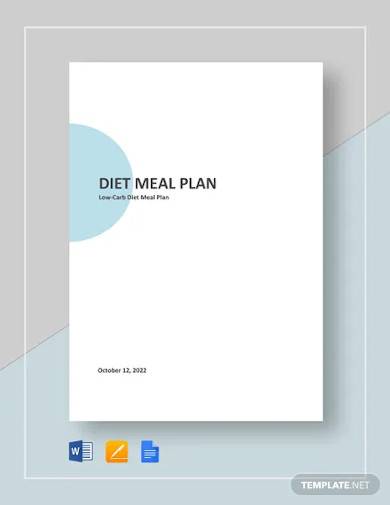
Daily Diet Planner Template
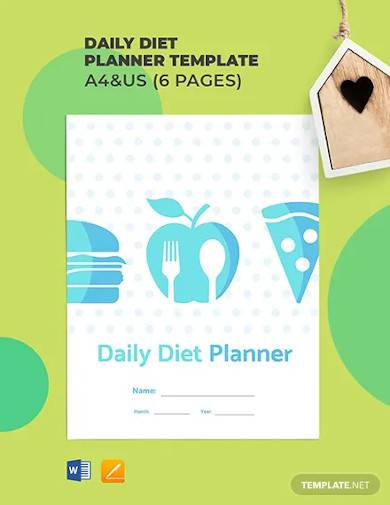
Weekly Diet Planner Template
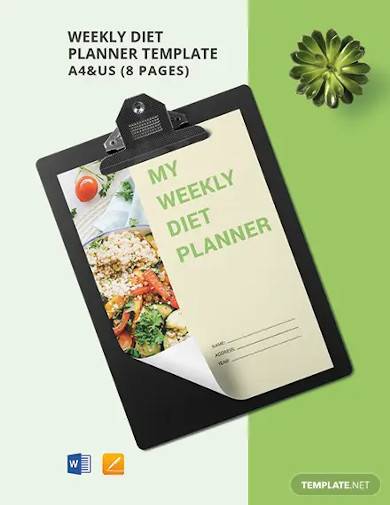
Weekly Diet Plan Template
How to Create a Diet Plan?
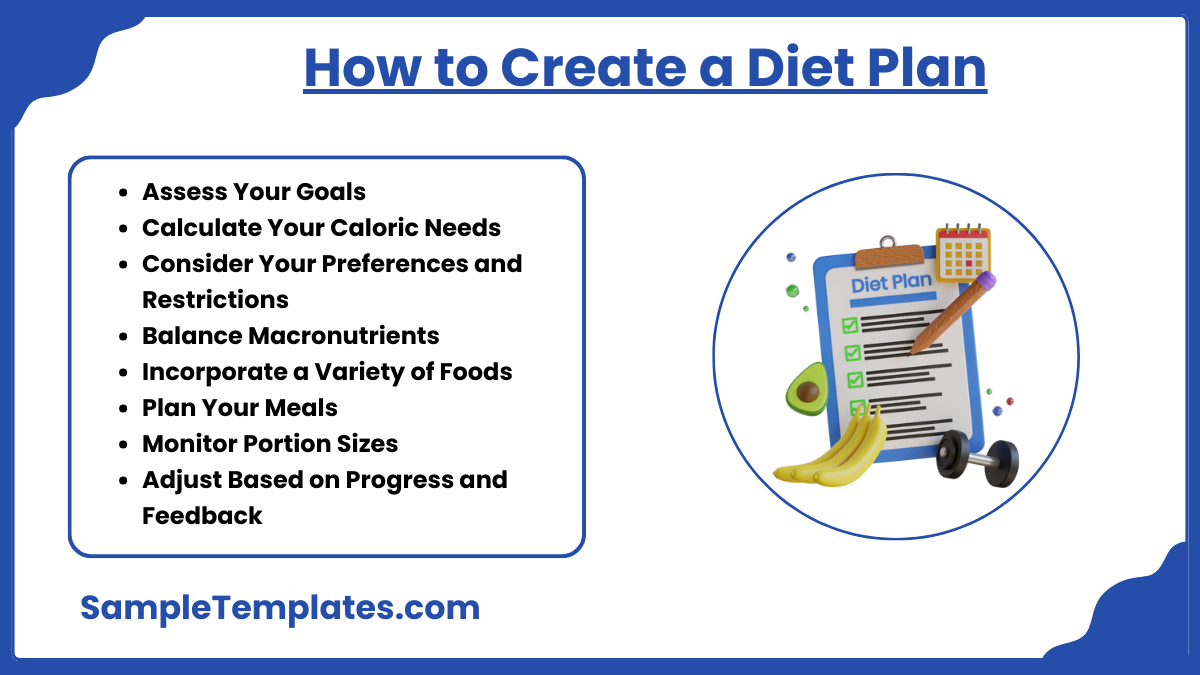
- Assess Your Goals: Determine what you want to achieve with your diet plan—whether it’s losing weight, gaining muscle, improving overall health, or managing a condition like diabetes. You Can also see more on Diet Chart.
- Calculate Your Caloric Needs: Estimate your daily caloric needs based on factors such as age, weight, height, gender, and physical activity level. There are many online calculators that can help with this.
- Consider Your Preferences and Restrictions: Take into account your food preferences, allergies, and any dietary restrictions. This will help ensure your diet plan is enjoyable and sustainable.
- Balance Macronutrients: Understand the balance of macronutrients (carbohydrates, proteins, and fats) that you need. This ratio can vary depending on your specific health goals and medical advice.
- Incorporate a Variety of Foods: Include a wide range of fruits, vegetables, whole grains, proteins, and healthy fats to ensure you get a full spectrum of nutrients.
- Plan Your Meals: Schedule your meals and snacks to fit your daily routine. Consistency is key in maintaining a balanced diet. You Can also see more on Meal Planning.
- Monitor Portion Sizes: Pay attention to portion sizes to avoid overeating. Use measuring cups or a digital food scale to keep track of how much you’re consuming.
- Adjust Based on Progress and Feedback: Regularly assess your progress towards your health goals and make adjustments to your diet plan as needed. Listening to your body’s feedback is crucial for making necessary tweaks.
Cross-fit Diet Plan Sample Template
Daily Diet Plan Template
Daily Diabetes Diet Plan and Guide
Uses of Diet Plan
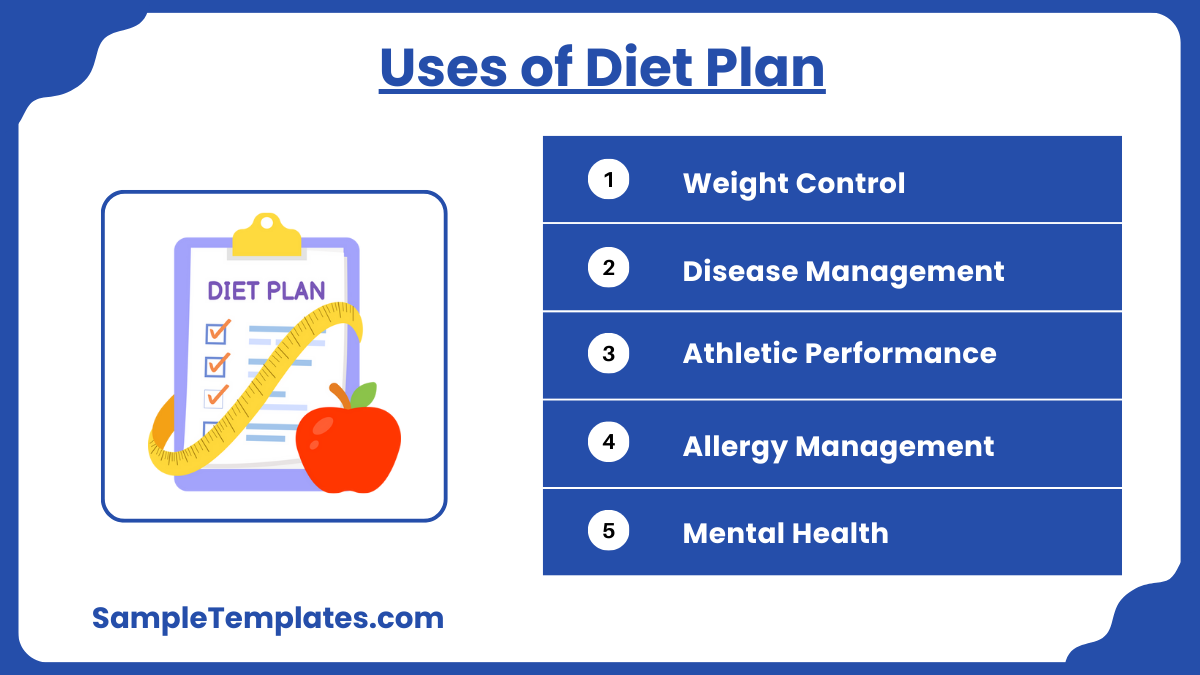
- Weight Management: A diet plan can help individuals gain, lose, or maintain weight by regulating calorie intake according to specific goals. You Can also see more on Weekly Meal Plan.
- Nutritional Balance: Ensuring that all necessary nutrients are consumed in appropriate amounts to support overall health, including vitamins, minerals, proteins, fats, and carbohydrates.
- Chronic Disease Management: Tailored diet plans can help manage conditions such as diabetes, heart disease, and high blood pressure by focusing on foods that affect these issues positively or negatively.
- Fitness and Athletic Performance: Athletes may use specific diet plans to enhance physical performance, increase energy levels, and facilitate recovery from exercise.
- Food Allergies and Intolerances: Individuals with dietary restrictions can use specialized diet plans to avoid allergens or irritants while still meeting nutritional needs. You Can also see more on Daily Meal Plan.
- Mental Health Support: Emerging research suggests that a healthy diet can influence mood and mental well-being, potentially mitigating symptoms of depression and anxiety.
Diet Plan for Weight Loss
Sample Diet Plans for Gestational Diabetes
Gluten Free Diet Plan Sample
Tips for Preparing a Diet Plan
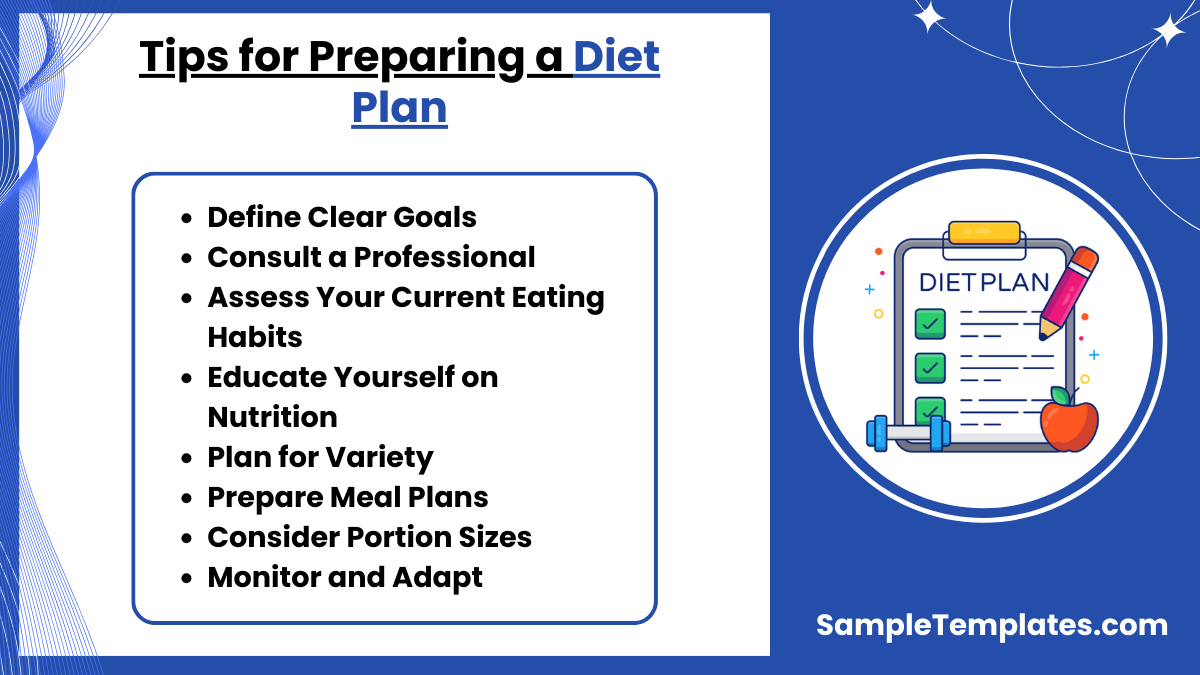
- Define Clear Goals: Establish specific, measurable, achievable, relevant, and time-bound (SMART) goals. Knowing whether you’re focusing on weight loss, muscle gain, or general health can guide your dietary choices.
- Consult a Professional: Speak with a dietitian or a nutritionist who can provide expert advice tailored to your health conditions, nutritional needs, and personal goals. You Can also see more on 7-Day Diet Plan.
- Assess Your Current Eating Habits: Keep a food diary for a few days to track what you eat and drink, your hunger levels, and how you feel after eating. This can help identify patterns and areas for improvement.
- Educate Yourself on Nutrition: Understand the basics of nutrition, including the functions and sources of macronutrients (carbohydrates, proteins, and fats) and micronutrients (vitamins and minerals).
- Plan for Variety: Include a wide range of foods in your diet to ensure comprehensive nutrition. Different colors and types of fruits, vegetables, grains, proteins, and fats can all contribute valuable nutrients.
- Prepare Meal Plans: Organize your meals and snacks ahead of time. Planning helps manage portion sizes and makes it easier to stick to your diet, especially when you’re busy or stressed.
- Consider Portion Sizes: Learn about appropriate portion sizes for different foods to avoid overeating. Using smaller plates, measuring cups, or a food scale can help control portions until you’re comfortable estimating them visually. You Can also see more on Meal Plan with Grocery List.
- Monitor and Adapt: Regularly review your progress and be open to making necessary adjustments. Your needs may change over time due to factors like age, activity level, or changes in health status.
Recommended Diet Plan for Women
Personal Diet Plan Template
2000 Calorie Gestational Diet Plan Sample
Low Carb Diet Plan Sample
Diet Plan Sample for Toddlers
Alkaline Diet Plan Sample
Importance of Diet Plan
- Promotes Nutritional Balance: A diet plan ensures that all food groups are appropriately represented, helping to meet daily nutritional requirements and preventing deficiencies.
- Aids in Weight Management: It helps manage body weight by controlling portion sizes and limiting junk food, aligning caloric intake with energy expenditure. You Can also see more on Meal Planner.
- Supports Chronic Disease Management: Diet plans can be tailored to help manage conditions such as diabetes, hypertension, and heart disease, by focusing on nutrient-dense foods and limiting harmful ones.
- Enhances Mental Health: There is a strong link between diet and mental health. A balanced diet can improve mood, reduce symptoms of depression and anxiety, and enhance overall mental well-being.
- Improves Energy Levels: Balanced meals with adequate macronutrients and micronutrients can help maintain consistent energy levels throughout the day.
- Optimizes Physical Performance: For athletes or physically active individuals, a specific diet plan can improve performance and recovery by providing the right balance of energy and nutrients.
- Customizes to Individual Needs: A diet plan can be tailored to individual allergies, intolerances, lifestyle preferences, and cultural habits, making it easier to stick to and enjoy. You Can also see more on Healthy Meal Plan.
- Educational Tool: Planning and following a diet plan can educate individuals on what they are consuming, helping them make informed choices about their nutrition and health.
Diet Plan Sample for Weight Loss
Counting Carbs and Diet Plan
What is a Diet Plan?
A diet plan is a meal plan that helps an individual achieve their health goals. It aids their weight loss journey and workout training, among others. More than being a trusted companion to exercise, it’s also a way for people to lead a robust lifestyle by following a healthy diet plan that contributes to their overall wellbeing. Diet plans are also useful in fulfilling a medical requirement to control a person’s blood sugar level, lower cholesterol count, and avoid allergy attacks.
FAQs
What diet plans are best for losing weight?
Here are some of the best diet plans for weight loss:
- Plant-based diets
- Intermittent fasting
- Low-fat diet
- Low-carb diet
- Mediterranean diet
What foods should you include on your diet plan if you aim to bulk up?
According to Healthline, here are the different foods to include in your diet plan:
- Dairy
- Grains
- Meat, poultry, fish
- Vegetables
- Fruits
Is a diet plan the same as a meal plan?
They work similarly and can be interchanged, but they differ slightly in usage. Diet plans usually refer to eating plans with a particular fitness goal or that achieves a fitness challenge. On the other hand, meal plans usually refer to assigning food choices on a schedule. You Can also see more on Weekly Meal Planner.
Creating a diet plan is a giant leap towards a three-sixty degree spin of a new lifestyle. It commences healthy habits and keeps you in perfect shape while going after your fitness goals. And you can start now! Waste no time and take one of our diet plan templates today!
Related Posts
6+ Sample Photography Business Plans Sample Templates
8+ Sample Audit Plan Templates – Word, PDF Sample Templates
11 Samples of Communication Plan Templates Sample Templates
12+ Product Plan Templates Sample Templates
9+ Sample Film Business Plans Sample Templates
11+ Implementation Plan Templates – PDF, Word Sample Templates
8+ Weekly Lesson Plan Samples Sample Templates
8+ Seminar Planning Templates Sample Templates
11+ Non Profit Business Plan Samples Sample Templates
9+ Sample Financial Plan Templates Sample Templates
12 Sample Unit Plan Templates to Download for Free Sample ...
9+ Toddler Lesson Plan Samples Sample Templates
9+ Territory Plan Templates Sample Templates
17+ Meal Planning Templates – PDF, Excel, Word Sample Templates
13+ Account Plan Templates Sample Templates

